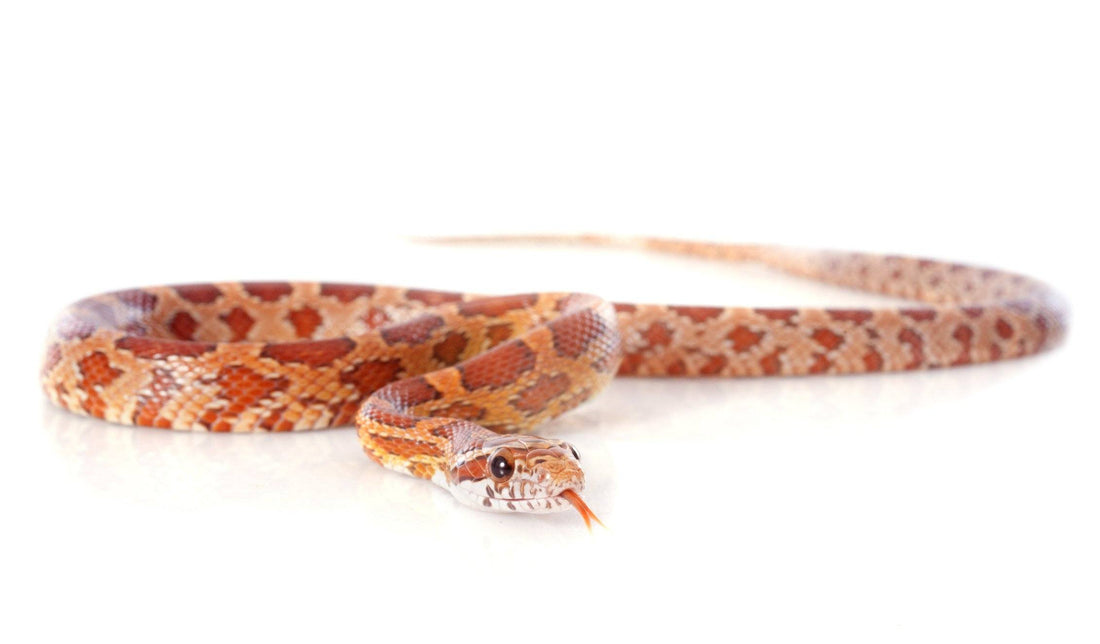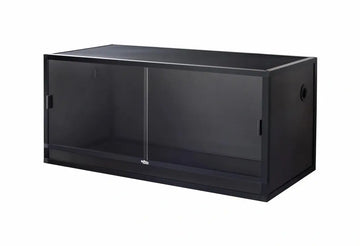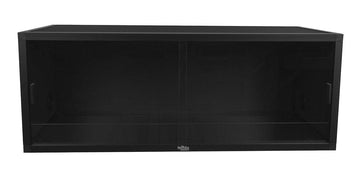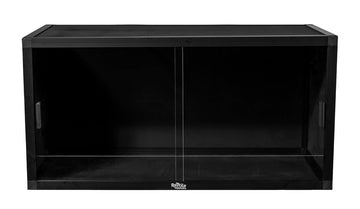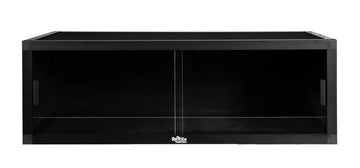Table of Contents
Introduction
Corn snakes (Pantherophis guttatus) are a 3-5’ long, crepuscular, semi-arboreal snake native to the southeastern United States, parts of Mexico, and the Cayman Islands. They prefer forested areas or woodlots for habitat, but can also be found in meadows and barns.
Corn snakes have slender, muscular bodies and an oval head, covered in smooth scales. Wild-type (“normal”) corn snakes have an orange or brownish-yellow base color with large, black-edged red or brown blotches down the back and a black and white checkered pattern on the belly. However, thanks to captive breeding efforts, corn snakes are now available in many other colors and patterns.
Corn snakes are one of the most common pet snakes in the US due to their hardiness, manageable size, docile nature, and ease of breeding in captivity. With good care, they are capable of living 15-25 years or more.
Enclosure
Minimum terrarium size for corn snakes
The absolute minimum terrarium size for a single corn snake is 48”L x 24”W x 24”H. Of course, larger is always better! Many people (falsely) believe that this is an unreasonable minimum for corn snakes because their slender build makes them appear smaller than they actually are. However, the fact is that they’re very active snakes, and need enough room to stretch out fully, explore, and climb.
Can corn snakes be kept together?
Cohabitation (keeping multiple corn snakes in one enclosure) is not recommended, as corn snakes are not a social species, and keeping them together can cause unnecessary stress. It can also cause accidents at feeding time.
Are tubs good enclosures for corn snakes?
You’ve probably seen videos on YouTube and posts on platforms like Instagram of people who keep their snakes in plastic tubs arranged on shelves. At first glance, this seems like an ideal arrangement: a way to keep more snakes in less space! The snakes seem happy and healthy enough in these posts, which further suggests tubs and racks as the ideal for snake housing. However, this is not the case.
As suggested by the specifications given above, plastic tubs are simply not large enough to fulfill an adult corn snake’s needs for space according to animal welfare guidelines. They are also unable to provide sufficient light, thermal gradient, or ventilation without significant modification. The Federation of British Herpetologists states: “Outside of these specific uses the FBH does not support the long-term use of rack systems for snakes where the physical movement of the animals is severely restricted.” Corn snakes that are housed in tubs over the long-term are more likely to suffer from health problems such as muscle weakness, obesity, etc.
How to quarantine a corn snake
When you bring home a new pet reptile, it’s best practice to quarantine it first, especially if you own other reptiles. It is especially important if you plan on housing your corn snake in a bioactive vivarium. Quarantine is the practice of isolating animals that have arrived from elsewhere or been exposed to infectious or contagious disease.
Even if you don’t have other reptiles, quarantine is still important because it allows you to closely monitor your snake for signs of illness and administer treatment. Corn snakes must be quarantined for a period of 3-6 months. You can use your snake’s long-term enclosure for quarantine, or you can use a large plastic tub. Although not ideal long-term housing, tubs are inexpensive, easy to clean, and make an excellent short-term option for quarantine purposes.
Here are some rules for quarantining your corn snake:
- Keep the snake in a separate room from other reptiles.
- Do not use the same equipment for the new snake as for your other reptiles.
- Fully disinfect the enclosure weekly.
- Get the snake checked by an experienced reptile veterinarian and treated for parasites if needed.
- Observe for symptoms of disease or illness.
After the quarantine period is over, if your corn snake is completely healthy, you can transfer it to its long-term enclosure.
Lighting
Do corn snakes need UVB?
Technically they can survive without it, but we still recommend providing appropriate UVB lighting for corn snakes. UVB lighting helps provide a clear day/night cycle, provides all of the vitamin D that your pet needs, strengthens the immune system, facilitates better digestion, and other benefits.
The best UVB bulbs for corn snakes housed in a 48” x 24” x 24” terrarium are:
For best results, house the UVB bulbs in a reflective fixture. Position the lamp on the same side of the terrarium as the heat lamp, about 9-11” above the basking area if over mesh, and 12-14” above the basking area if not.
UVB is blocked by glass and plastic, so placing the terrarium in front of a window doesn’t count as “free UVB” — in fact it can make your terrarium too hot due to the greenhouse effect. Don’t forget to replace your bulb every 12 months!
Lights should be on for about 13 hours/day during summer and 11 hours/day during winter in order to encourage natural hormonal cycling. All lamps should be turned off at night.
How to measure UVI
The strength of a lamp’s UVB output is measured in UV Index, or UVI. Coincidentally, this is the same measurement that the World Health Organization uses to measure risk of skin damage from exposure to solar radiation. The best way to measure UVI in your corn snake’s enclosure is with a Solarmeter 6.5.
To use the Solarmeter, hold the device vertically at the height of the basking surface, with the lens pointing directly up at the lamp. Corn snakes should have a basking UVI between 2.0-3.0, with UVI everywhere else in the enclosure being lower. Although there is a basking distance recommended in the previous section, note that factors such as the density of your terrarium mesh as well as the exact hood you’re using for your UVB lamp will affect the exact distance needed.
Heating
Best temperature for corn snakes
Like other reptiles, corn snakes are cold-blooded, which means that they rely on external temperatures to manage their own body temperature and metabolism. A reptile’s enclosure should offer a range of temperatures to allow them to thermoregulate effectively.
Specifically speaking, corn snakes should have a basking surface temperature of 90°F. On the other side of the enclosure, the temperature should be around 75°F. Surface temperatures can be measured with an infrared thermometer, but air temperatures should be measured with a digital probe thermometer.
Provide heat for your snake with at least two halogen flood heat bulbs, placed close together over the basking area (ex: a piece of flagstone or stone paver) to evenly heat the snake’s entire body. Do not use ceramic heat emitters (CHEs), red bulbs, or blue bulbs, as these are not as effective.
Are heat mats better than heat lamps?
Heat mats have been used for years for heating snakes, but as our understanding of snake housing has evolved, so has our understanding of snake heating. While heat mats can be sufficient in a small tank or tub, they are not enough to create both appropriate basking and air temperatures in a larger enclosure, particularly not for diurnal, climbing species. However, heat mats can be very effective for maintaining a warm hide on an as-needed basis.
Heat lamps produce a higher-intensity form of infrared that allows reptiles to bask more efficiently. Plus, they are able to heat the surfaces beneath them (creating “belly heat”) while also warming the air inside the enclosure. And finally, heat mats can’t be used to create elevated (arboreal) basking sites.
Of course, because they produce light, heat lamps are not suitable for use at night. If you are having trouble maintaining appropriate nighttime temperatures for your snake, it’s best to use a ceramic heat emitter or radiant heat panel to warm the enclosure.
Humidity
Best humidity levels for corn snakes
Corn snakes need an average humidity of 65-75%. There should also be a humid hide for your snake, lined with moistened sphagnum moss. Humidity should be measured via digital probe hygrometer, with the probe placed in the middle of the terrarium.
Increase humidity by misting your snake’s enclosure 1-2x/day with a spray bottle. Mist first thing in the morning and then again at night if needed. Mixing water directly into the substrate also helps with maintaining high humidity.
How to create a humid hide for your corn snake
In addition to a warm hide, your corn snake should also have a humid hide available in the middle to cool end of the enclosure. This hide functions like a humid burrow or hollow log to which the snake can retreat when they feel the need for a bit of extra moisture. Having access to a humid hide is essential to maintaining a well-hydrated corn snake that consistently sheds well.
You can either purchase a humid hide or make your own. There are several attractive commercial options for humid hides, such as the Zilla Rock Lair and the Exo Terra Snake Cave. These products are fully-enclosed and easy to clean. To DIY your own humid hide, use a tupperware container with a hole cut out for an entrance. Either way, line the hide with moistened paper towel or sphagnum moss. Paper towel must be replaced every 1-3 days to stay clean, while sphagnum moss must be replaced every 2-4 weeks.
Substrate
Best substrate for corn snakes
Providing a thick layer of naturalistic substrate (“bedding”) will help cushion your corn snake’s body, maintain correct humidity levels, and also helps make your enclosure more attractive! We recommend the following substrates for corn snakes:
Layering clean, chemical-free leaf litter on top of the substrate can also help with humidity.
Substrate should be at least 4” deep and completely replaced every 3-4 months. Remove poop and urates daily, along with contaminated substrate.
What to know about cleaning a corn snake enclosure
Replacing your pet’s substrate is a good time to give the entire enclosure a good cleanout. Here are some general steps to follow:
- Remove your snake from the enclosure and put it inside a temporary, escape-proof holding container. This container should offer a hide, small water bowl, and a thin layer of old substrate from the enclosure for the snake’s comfort.
- Remove all substrate and décor.
- Vacuum and wipe down the enclosure to remove leftover particles.
- Apply a reptile-safe disinfectant to the floor and walls of the enclosure and let sit for the disinfectant’s recommended contact time.
- Meanwhile, soak branches, rocks, hides, and other decor in a disinfectant rated for porous materials for the recommended contact time.
- If required, rinse the enclosure and the accessories with clean water to remove disinfectant residue. Allow everything to dry.
- Pour new substrate into the enclosure. Mix in water until uniformly moistened but not wet.
- Arrange décor. If your pet is easily stressed by change, put everything back where it was before.
- Reintroduce your snake to the clean setup.
Some veterinary-grade disinfectant options that work for both porous and nonporous materials are F10SC, CleanBreak, and bleach solution. However, for porous materials, bleach solution should be in a 1:10 dilution, while you should use 1:50 for nonporous.
Can bioactive work for corn snakes?
Absolutely. Bioactive vivariums can be a good choice of housing for corn snakes because they are conducive to higher humidity levels and provide plenty of foliage in the higher levels of the enclosure. Bioactive vivariums have the additional benefit of eliminating the need for total cleanouts, and a healthy vivarium always has a fresh, earthy aroma.
Some downsides of bioactive are that they require at least one month to get established before the snake is introduced, the plants that you use need to be sturdy enough not to get crushed, and bioactive is usually more expensive to set up in the short-term. CUC (Clean Up Crew) organisms may occasionally escape, and maintenance in the form of plant care and occasional partial soil replacements are still necessary.
If you want to put together a bioactive setup for your corn snake, you will need all of the supplies recommended in this article, plus a few more things:
- bioactive-ready temperate substrate mix
- clean leaf litter
- sturdy live tropical plants that can withstand occasional snake traffic
- 6500K LED or fluorescent grow lamp, spanning most of the enclosure’s length
- temperate/tropical CUC organisms to maintain the soil
While it’s possible to mix your own temperate bioactive substrate, if this is your first attempt at bioactive, you’re most likely to have success if you use a pre-mixed bioactive substrate available commercially, such as through Bio Dude or Josh’s Frogs.
Good options for CUC for a bioactive corn snake vivarium include: dwarf white isopods, powder orange/blue isopods, springtails, and superworms.
Décor
How to decorate a corn snake terrarium
An empty terrarium makes for a bored corn snake, reducing its quality of life. Keep your pet entertained and engaged with its environment with the strategic use of décor items that encourage it to exercise natural behaviors!
Since corn snakes are natural climbers, at bare minimum you will need at least two hiding places on the ground and a branch or two for it to climb on. However, it’s best to include other items such as:
Live plant options for corn snakes
Corn snakes may not be particularly large or heavy, but they are still capable of trampling their live plants if you don’t take the right precautions. This means that you need to be careful in selecting plants that are the most likely to resist occasional trampling as well as climbing. Here are some plants that are robust and do well in a moderately humid, moderately-lit environment:
- Dracaena
- Ficus
- Peperomia
- Philodendron
- Pothos
- Schefflera
- Spider plant
Larger, older plants are more expensive to buy, but they are also sturdier and more likely to survive your snake.
Food
What to feed to a corn snake
Corn snakes are carnivorous, which means that they need to eat whole animal prey in order to get the right nutrition. Here is a basic feeding schedule based on snake size:
- Hatchlings (<18″ long) should be fed once every 5-7 days.
- Juveniles (18-36″ long) should be fed once every 7-10 days.
- Adults (>36″ long) should be fed once every 10-14 days.
Prey items should be around 10% of the snake’s weight and no more than 1.5x its width at its widest point. Although live prey can be offered, it’s best to use frozen whenever possible. Prey should be thawed in a BPA-free plastic bag in warm water until it reaches ~100°F, then use a pair of soft-tipped feeding tweezers to offer it to your snake.
One of the keys to great nutrition is variety, so aside from offering mice and rats, quail, chicks, and quail eggs can also be used to add diversity to your snake’s diet.
Where to get feeders for your snake
Most pet stores sell frozen mice and rats in various sizes for feeding to snakes. This is convenient because you can buy prey one at a time. However, the variety is most likely to be highly limited, and quality is questionable since there are no controls for how the feeders are raised or how healthy they are at the time of euthanasia.
Alternatively, you can buy feeders from a breeder online. The internet makes it easier to get a variety of prey for feeding your pet, and it gives you more control over the quality of prey and the way they were raised. However, you often have to buy in bulk, and shipping costs are relatively high due to the need to ship perishable goods quickly.
Do corn snakes need vitamin supplements?
Corn snakes can survive without dietary supplements, but using them every once in a while can help prevent your snake from developing a nutritional deficiency, helping it live healthier. We recommend Repashy Calcium Plus LoD, lightly dusted on the prey item before offering.
Providing drinking water for corn snakes
Of course, don’t forget a large water bowl for your snake to drink from and soak in! Change the water daily and scrub the bowl with a reptile-safe disinfectant weekly, or whenever it becomes soiled.
Handling
How to handle your corn snake
Reptiles generally don’t appreciate petting and handling in the same way that dogs and cats do. That being said, corn snakes generally tolerate human interaction pretty well! When picking up your corn snake, be gentle and try to pick it up from the side or below rather than from above. Support as much of its body as possible, and NEVER pick it up by its tail, as this can damage its spine!
Taming tips for corn snakes
Corn snakes are known for being very energetic and fast-moving, especially when they are young. They still have a reputation for being fairly easy to tame, but it still takes some work on your part. If you don’t gain their trust, they can become defensive and skittish, so most of the work on your end will be establishing clear communication and creating a positive association with yourself in their mind. It’s best to encourage the snake to come out of the enclosure and climb onto you on their own, rather than simply grabbing them whenever you’re in the mood for handling. Never grab your pet out from its hiding place, as this is a very effective way to make it feel unsafe.
Worried about getting bitten? While a corn snake bite is extremely minor, it helps to teach your pet to tell the difference between food time and handling time. One way to do this is by tapping on the front of the enclosure with your fingernails right before offering food, so the snake associates tapping with food. When it’s handling time, don’t tap. Of course, if the snake still looks coiled and interested, you can use a paper towel roll to gently tap the snake on the head and distract it from thinking about food.
Additional training is very worthwhile for building up a trust relationship with your pet. You can get expert tips from professional snake trainers like Lori Torrini on YouTube.
How to provide enrichment for a corn snake
Enrichment is the practice of strategically providing items and activities to encourage a captive animal to exercise natural behaviors. This also helps increase activity, reduce stress, and generally increase the animal’s welfare.
Some argue that snakes are “too dumb” to benefit from enrichment, but this is false. Snakes, including corn snakes, can absolutely benefit from enrichment when it is provided in snake-appropriate ways. Here are some ways to provide enrichment for your pet:
- Rearrange the enclosure. If total overhauls are too stressful, move one thing every so often at your snake’s pace. For some individuals, that may be once a month, for others they might like once a week.
- Puzzle feeders. This can be as simple as placing the snake’s prey in an open box or plastic cup.
- Simulated nest raids. Instead of offering one prey item, place a cluster of much smaller prey (ex: pinky mice or quail eggs) somewhere in the enclosure for the snake to find.
- Supervised explore time outside of the enclosure. Make sure to keep them away from situations that you can’t get the snake out of.
- “Box of things”. Introduce your snake to a box or bin full of different items of different sizes and textures: branches, pipes, easily-washable plushies, etc.!
Health
When should you take a corn snake to the vet?
Dogs and cats aren’t the only pets who need veterinary care — snakes get sick and need professional help the same as any other pet. If you notice that your snake has any of the following symptoms, make an appointment with an experienced reptile vet right away:
- Noisy breathing
- Mucus discharge from the mouth/nose
- Unexplained weight loss
- Large patches of missing scales
- Discolored belly scales
- Swelling or bumps anywhere on the body
- Sudden, unusually aggressive behavior
Resources
This care sheet contains only very basic information. Although it’s a good introduction, please further your research with high-quality sources. The more you know, the better you will be able to care for your pet! Here are some great sources we recommend checking out:
- The ReptiFiles Corn Snake Care Guide
- “Corn Snakes: The Comprehensive Owner’s Guide” by Kathy Love and Bill Love

